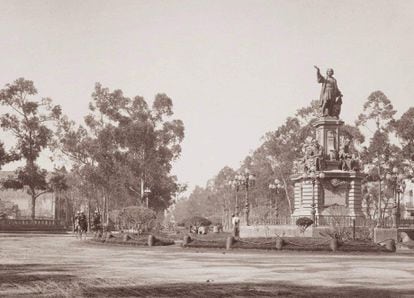Monument to Christopher Columbus, created by artist Charles Cordier in 1877.
The announced installation on the Paseo de la Reforma in Mexico City of a monumental sculpture called
Tlali
, which represents the head of an indigenous woman, and which will replace the monument dedicated to Christopher Columbus that, for decades, occupied a notorious pedestal on the main avenue of the capital, represents the most recent episode of a controversy that has been flying over the discussion for some time public in Mexico and other countries, and that can be summarized in a series of related questions: what and to whom should the public spaces of our cities commemorate? Which characters deserve to be consecrated the relative eternity of a statue and which would be convenient to be removed from the place that the societies of the past granted them? What do the sculptures that we decide to populate the avenues, roundabouts, parks and hemicycles say about our identity? Are statues good for anything,apart from being the latrine of the pigeons and the reference point of the taxi drivers?
Busts and monuments are not as trivial a matter as it might seem: they have appeared in all civilizations. Gods, heroes, kings, conquerors, but also rebellious and rebellious, also characters who are considered admirable for their genius, intelligence, devotion, self-denial or goodness, have been celebrated in wood, stone or metal. And, in the same way, human societies have been granted other statues to highlight abstractions or symbols that remind them of their origins, aspirations or achievements. Beauty, freedom, patriotism, motherhood, purity, work are exalted ... What best suits the moment, which is still paradoxical for pieces that strive to seek permanence.
Because statues are not born from the ground and by themselves and, therefore, they are not neutral, like trees or hills. You have to put them where they are and pay for them and, therefore, they represent the dominant and hegemonic ideas of a certain era. But, given that ordinary citizens do not have the time, money or, in general, the desire to go about lifting them, they are also, above all, a symptom of the opinions and interests of the Governments and States that have them sculpted. and to place and that, in some way, they pretend to interpret the will of the citizens when imposing them.
Mexico is full of busts in honor of the patriotic heroes vindicated by their successive governments. Thanks to the nationalism that the PRI cackled so much, in every city and town in the country there are one or more Juárez, Hidalgos, Morelos and a multitude of Lázaros Cárdenas. At this point, we can say that these are more or less established characters in the popular imagination and that no one expects them to take them down. But there are also dozens more out there with much less consensus. General García Barragán, for example, who was Secretary of Defense at the time of the Tlatelolco massacre and whose representations are usually stained with blood-red paint ... And what about the Colosios that dot the landscape here and there? But it is not only in the PRI that there is air: the PAN members managed to raise statues for him, where they could,his former presidential candidate Manuel J. Clouthier when they came to power.
It is very likely that those who maintain that Mexicans, today, do not feel that Columbus is represented by the majority, and that many of them consider him a doubtful or nefarious character, as he was the precursor of the American conquest and colonization, are right. But, in that same line of thought, what would ordinary citizens want to put in their place? A colossal head, like
Tlali
, which is assumed to be Olmec but has a Nahuatl name? If we did an open poll, wouldn't we run the risk of ending up with a giant Baby Yoda there, instead of some patriot figure?
It is impossible not to think, thanks to this mess, in the history of the Caballito, the equestrian statue of the Spanish King Carlos IV, sculpted by the great Manuel Tolsá, who spent more than a century in the Paseo de la Reforma itself until it was decided, I think that reasonably, there was no reason to honor an overseas colonial king in such a way. But Mexicans, who are great, found at that time a solution to match our historical confusions: the
Caballito
was preserved "out of respect for art", but in another less attractive location, and in the place where it stood a metallic, curvilinear and at the same time angular reinterpretation of the monument, a new
horse
but without a mounted king. I don't know anyone who likes the second
Horse
, but at least taxi drivers can continue to use it as a point of reference ...
Subscribe here
to the
newsletter
of EL PAÍS México and receive all the informative keys of the current situation of this country

